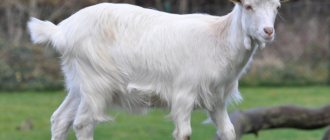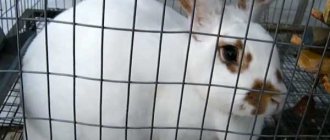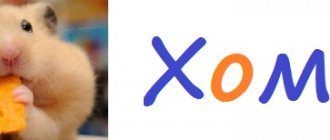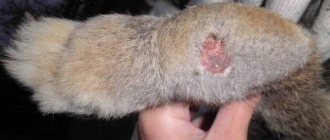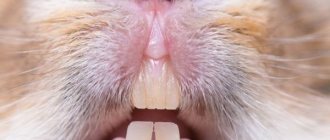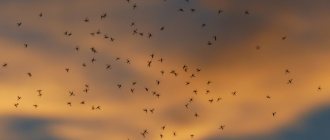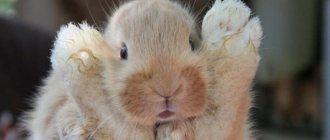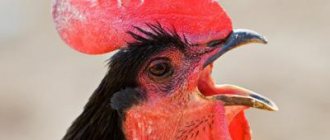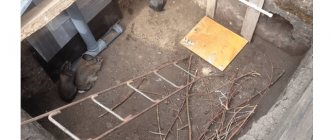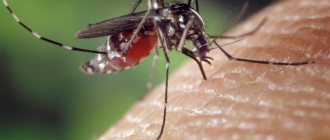- home
- Rabbits
- Breeding
07/04/2018 Many farmers breed these animals because it is very profitable. But beginning rabbit breeders may have quite a lot of questions related to sexual hunting and mating.
How to tell if a female rabbit is in heat
Often, mating occurs immediately after sexual intercourse. How do you understand that this period has arrived?
The main signs are:
- excessive worry;
- aggression;
- lethargy;
- refusal of food;
- slouch;
- decreased activity;
- the external genitalia are red or swollen;
- the rabbit can run around the cage, press against the walls and rub against them.
It will also be useful for you to learn how rabbits mate and how pregnancy occurs in rabbits.
Folligon for rabbits
The drug (Folligon) is Gonadotropin from the serum of pregnant mares (PGS). Produced by the Dutch. It can be bought in veterinary pharmacies in Russia and Belarus. In appearance it is a lyophilized white tablet. A solvent is included with the product.
The drug contains as an active ingredient 1000 or 5000 IU of gonadotropin from the serum of pregnant mares (PGS). Gonadotropin is supplied with a solvent in a 5 ml bottle. Gonadotropic serum of pregnant mares contains a hormone that has the ability to induce the growth and development of the egg and stimulate ovulation. Folligon is used for female rabbits:
Why doesn't the female rabbit come into heat?
Sometimes the female does not show sexual desire towards the male. This can happen for various reasons.
- A delay in readiness for mating can occur due to an incorrectly selected diet or lack of vitamins and minerals.
- Insufficient daylight hours (less than 7 hours per day).
- An excessive amount of offspring weakens the animal.
- Weather conditions – excessively high or low ambient temperatures.
- Pet obesity.
- Elderly age. In this case, it is impossible to stimulate the female to mate.
- Disturbances in the functioning of the reproductive organs.
- Small cage.
Important! If an animal is obese or underweight, it is necessary to immediately adjust its diet.
Factors of influence
The behavior of the female during the hunting period is directly influenced by the season, time of day, feeding and housing conditions, as well as weather. The most stimulating factors are the season, feeding and proximity to males. The lack of effective and complete lighting has a detrimental effect on the body and, as a result, on the behavior of the female rabbit during the hunting period. To do this, in winter and autumn, as well as in early spring, 14-15 days before mating, it is necessary to increase daylight hours, which can be done with the help of artificial lighting. Also avoid foods containing high doses of vitamins.
In winter, it often happens that the hunting period for females goes almost unnoticed. The only factor by which this can be determined is that the female rabbit constantly watches the male and chases him throughout the cage, trying to turn around with her back part of her body when approaching. This means that your pet's hunting season has already begun.
How to induce heat in a female rabbit
When a female does not want to mate with a male, you can induce the desire yourself.
The following recommendations will tell you how to get your rabbit to do this:
- It is necessary to determine why the female refuses the male.
- You can stimulate the individual with vitamins.
- If there is insufficient lighting, the cells are taken out into the sun.
- Include celery in your diet.
In order for the female rabbit to properly experience the mating period, it is necessary to carefully monitor her behavior and, if any signs of illness appear, show her to the veterinarian.
Postpartum care for the female rabbit and offspring
When the rabbit has given birth, what to do next? The cubs are born hairless, deaf and blind. On the 3rd day of life, hairs begin to appear on the body. Rabbits begin to see only on the 10th-11th day. While the cubs are lying in the queen cell, the rabbit takes care of them. During the postpartum period, the female must also be looked after; she needs high-quality nutrition with vitamin and mineral supplements.
We must not forget about water. Animals should maintain a temperature of at least 18°C in the room where they live. It is important to monitor the general condition of the female rabbit and cubs, whether the female has a full appetite, whether she is active, etc.
Rabbits have a well-developed maternal instinct, and they can take care of their offspring themselves up to two weeks of age. Then the female begins to leave the nest. At this time, it is very important to gradually accustom the rabbits to regular feed mixtures:
Food for the cubs must be of high quality. If grass is served, it is important to pre-treat it with pesticides. Hay must be supplied only well-dried, free from rot and mold. You need to put a drinking bowl in the rabbits' cage and make sure it is filled. Standard bedding for cubs is not suitable; experienced breeders advise placing a rag or towel in the cage.
Baby rabbits
When to happen again
After giving birth, when can you cover a female rabbit? In order to again fertilize a female who previously gave birth to dead rabbits, it is necessary to understand the reasons for what happened and take measures to eliminate undesirable factors, if possible.
Rabbits - female and male
The mother rabbit gave birth to dead rabbits, when can she now be born:
- If it was a stressful situation for the animal, it is necessary to eliminate the source;
- If improper feeding is noticed, completely or partially change the diet, improve it so that the rabbit can regain her strength for subsequent births;
- After an illness, a period of rehabilitation is required, which ends only after the animal has fully recovered.
Rabbits
When miscarriages occur more than once in one rabbit, the rabbit breeder should think about replacing the animal with another that can give birth to healthy babies.
Important! Rabbit breeders with sufficient experience are of the opinion that no matter what the birth, it is better to give the female rabbit a break for at least a month. But the owner himself decides how long after giving birth the rabbit can be covered.
Rabbits, if all maintenance standards are observed, can produce healthy offspring. If a miscarriage occurs, the rabbit breeder needs, first of all, to establish the reason why this happened and eliminate it. It is important to adhere to the chosen timing to mate rabbits. Then only strong rabbits will be born on the farm.
4.5 4 votes
Article rating
Reasons for female refusal to mate
Even rabbits, known for their ability to mate all year round, have situations where mating does not occur. There are many reasons for this:
- Unsuitable conditions – the room is too hot or too cold. The female rabbit may not let the male near her if she instinctively feels that in such conditions she will not be able to safely bear offspring.
- Lack of nutrients, poor diet. The reason for the lack of desire to mate is still the same - the animal is weakened, and therefore intuitively avoids sexual contact, fearing that it will not be able to bear cubs.
- The rabbit experiences discomfort - if the cage is crowded, such conditions are not conducive to sexual play.
- Insufficient lighting in the room, short daylight hours.
- Age - older females are not ready for mating as often as in their youth, their hormonal levels change.
- The rabbit did not like the gentleman, or she wants to flirt with him for a while.
- The female is pregnant, so she does not go into heat.
- Infections of the genital organs. If the female does not want to cover herself, you need to check if she has any suspicious discharge from the vulva - mucus, pus.
Features of choosing partners
The correct choice of rabbits for breeding determines what kind of offspring there will be and, accordingly, the profit from the animals. The process of selecting manufacturers should be approached with special care.
There are some criteria by which selection is made:
- live weight of the rabbit;
- amount of increase;
- immunity to diseases;
- fertility;
- milkiness;
- maternal instinct.
The main characteristics by which rabbits are selected for breeding:
- muscular, rounded croup;
- milk production of the rabbit;
- litter survival;
- number of live and dead newborns in the litter;
- the number of young animals surviving before weaning;
- total live weight of the offspring at three weeks of age;
- total live weight of babies at the time of weaning.
Determination of gender
Before you start breeding rabbits, you should determine their gender. This is not as simple as it might seem at first glance. Moreover, such an activity will seem difficult for a person who is encountering this for the first time.
To determine the sex, you need to place the rabbit on its back, lower its tail, and press with your fingers on both sides near the rabbit's genitals. In a female individual, the genitals look like a loop or hood with a slit (genital slit). In males, the genital organ is formed in the form of a tube with a round hole in the middle.
04:45
How to determine the sex of a rabbit//Female or male?
Choosing the right rabbit
Choosing a female rabbit for mating is not so difficult. First, assess the age of the animal: the female should not be younger than 6 months, since at a younger age she will not be able to bear offspring normally. Of course, the best option would be young individuals who have already given birth to rabbits and then conscientiously fed them. In this case, already 45 days after the previous litter, the female can be bred again.
It happens that a mother rabbit eats her babies. If this happened, there is no need for this female to happen again.
A female rabbit for breeding must correspond to the breed characteristics as much as possible
An equally important criterion for choosing a young rabbit to mate with is her weight. The female should be moderately well-fed, but not suffer from obesity. If the animal is thin, you should start fattening it. The female rabbit must be in the hunting stage, because without this the mating will not work. If a specific day of the month has been selected for mating, the female should be separated from her relatives for a while.
At what age can rabbits be bred?
To determine the age for mating as correctly as possible, one should take into account the fact that rabbits do not live long, about 9-10 years, and already from the 5th year of life the percentage of successful matings drops, therefore it is recommended not to mate. In addition, in old age there is a sharp decrease in the volume of milk in female rabbits after the birth of offspring, so the female cannot feed them on her own.
In rabbits, the process of aging and the extinction of maternal instincts is an individual feature . It often happens that, by all academic parameters, a male or female is subject to culling, but at the same time they still produce numerous and healthy offspring. But as statistics show, regardless of the age at which the first mating occurred, the animal can give birth to strong young rabbits during the first 2-3 years of its life.
How to choose rabbits?
When selecting rabbits for breeding, experienced rabbit breeders focus on the distinctive qualities of the animals:
- Lively temperamentDeep and wide chest;
- Resistance to heat and cold, strong immunity;
- Quick adaptation to new conditions;
- Elastic and dense skin;
- Thick, shiny coat without bald spots or excess plumpness;
- Regular and consistently high number of individuals in the offspring;
- Uniform and normal in duration breaks between births;
- Multiple births, milk production.
Culling of rabbits is carried out by excluding from the herd individuals that are partially or completely unsuitable for reproduction. Culling is carried out after several matings.
What is culling?
Rabbits are subject to culling, regardless of the condition, if they have physiological deficiencies:
- the chest is excessively narrow;
- weak muscles;
- the distinctive features of the breed, approved in accordance with standard requirements, are not particularly highlighted;
- the back is very concave or arched;
- croup sags, narrowed loin;
- the skin sags;
- the stomach is flabby, sagging;
- very large dewlap (not acceptable for males);
- underdeveloped or underdeveloped bones;
- the front legs are X- or O-shaped;
- the hind legs are very narrow or incorrectly formed;
- females have a coarse type of head, and males have a feminine, refined shape;
- the color and type of coat is atypical for this breed;
- wool with bald spots, sparse, patchy;
- the ears droop too much (with the exception of lop-eared rabbits) or are unacceptably thin.
Possible reasons for a female’s refusal to mate
- Extreme heat during which the animal has difficulty regulating its body temperature. This usually occurs in June-July.
- Unbalanced diet or lack of nutrients.
- Lack of the required amount of vitamins and minerals in the feed.
- Less than 7 hours of daylight.
- A large number of young animals from previous offspring.
- Any disease that forces the body to spend energy on destroying pathogenic flora.
- Obesity.
- Old age.
- Lack of free space when kept in a cage.
- Unsuitable partner.
- Stress.
- Shedding.
Prevention
To ensure that all of the above problems do not affect rabbit farming at all or happen as rarely as possible, it is necessary to carry out constant prevention. Then the females’ pregnancy will proceed without complications, and the baby rabbits will be born healthy and strong. In this case, it will be necessary to make some efforts to prevent the situations described above.
Prevention of rabbits
Here are the preventive measures you need to take:
- Feeding a rabbit must be approached with the utmost seriousness. Feed should be varied and of high quality. There should be plenty of them;
- It is better to reduce stressful situations affecting the animal to a safe minimum. The room for him is spacious and separated from the rest of the rabbits. If possible, the area should be as quiet as possible. It is preferable to handle such an animal carefully and carefully, without sudden movements or loud voices;
Feeding a pregnant female - The location of the female must be kept clean, disinfected, and have good ventilation;
- Give the female water clean and fresh. The water container is washed before each filling with liquid;
- It would be better to carry out mating using standard technology, this way you can ensure the health of the rabbit for a longer period;
- Vaccinations of animals should be carried out strictly according to the recommended periods so that other animals cannot become infected.
Pregnant female
If a miscarriage occurs once, you can use the services of laboratories where biomaterial is sent to determine the true cause, so that this does not happen again in the future.
